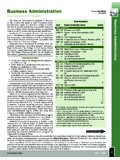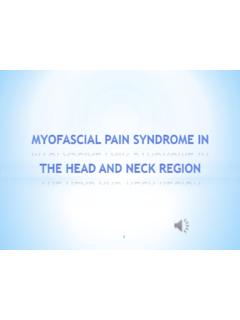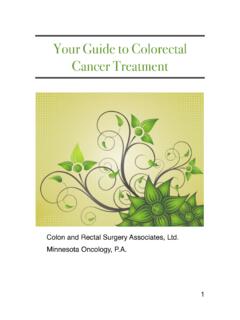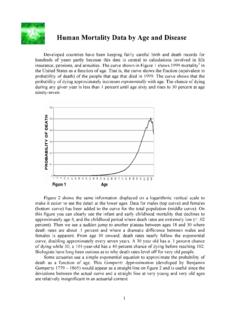Transcription of Structures of Urinary System - MCCC
1 Bio217 Fall 2012 Unit VIII 1 Bio217: Pathophysiology Class Notes Professor Linda Falkow Unit VIII: Urinary (Renal) System Disorders and Reproductive System Disorders Chapter 28: structure & Function of Renal & Urologic Systems Chapter 29: Alterations of Renal & Urinary Tract Function Chapter 31: structure and Function of Reproductive Systems Chapter 32: Alterations of the Reproductive Systems Structures of Urinary System Kidneys (2) Retroperitoneal Renal capsule Adipose capsule Renal fascia Hilum Ureters (2) Urinary Bladder (1) Urethra (1) Structures of the Kidney Cortex Medulla Pyramids Calyces Minor and major Renal pelvis Nephron million nephrons per kidney Functional unit of the kidney Cortical nephrons Juxtamedullary nephrons Parts of nephron Renal corpuscle (=glomerulus + Bowman capsule) Renal tubules Proximal tubule (pct) Loop of Henle Distal tubule (dct) Nephron Nephron Glomerular filtration membrane Blood passes through the three layers and forms the filtrate Bio217 Fall 2012 Unit VIII 2 Nephron Juxtaglomerular apparatus Juxtaglomerular cells ( renin) Macula densa (sense changes in Na+)
2 Renin-angiotensin pathway: reg. BP Decr. blood vol. or decr. Na+ incr. renin Angiotensin I Angiotensin II aldosterone (incr. reabsorption of Na+ and H2O) Juxtaglomerular Apparatus Structures of Urinary System Urinary Bladder Detrusor muscle Trigone Micturition reflex Urethra Internal and external sphincters 3 to 4 cm in females 18 to 20 cm in males Urinary Bladder and Urethra Renal Blood Flow Receive 1000 to 1200 mL of blood/min. Glomerular filtration rate (GFR) Autoregulation Tubuloglomerular feedback Renal Blood Flow Neural regulation Hormones Renin-angiotensin System Aldosterone ADH (conserves water/incr. water reabsorption) Bio217 Fall 2012 Unit VIII 3 Renal Blood Flow Nephron Function Filters plasma Reabsorbs and secretes Tubular reabsorption and secretion Forms a filtrate of protein-free fluid Regulates filtrate to maintain fluid volume, electrolytes, and pH Nephron Function Glomerular filtration Net filtration pressure Glomerular capillary oncotic/hydrostatic pressure Bowman capsule oncotic/hydrostatic pressure Filtration rate 180 L/day Concentration and Dilution of Urine Countercurrent exchange System Contributes to production of concentrated urine Concentration and Dilution of Urine Aldosterone Antidiuretic hormone (ADH) Atrial natriuretic peptide (ANP) produced by RA, when RA press.
3 Increases, inhibits secretion of renin Diuretics enhance urine flow (by disrupting Na+ reabsorption and decr. ECF vol. Urinary Tract Obstruction Urinary tract obstruction interference with flow of urine at any site along Urinary tract Obstruction can be caused by anatomic or functional defect Obstructive uropathy changes in Urinary System due to obstructions (anatomic) Bio217 Fall 2012 Unit VIII 4 Urinary Tract Obstruction Urinary Tract Infection (UTI) UTI - inflammation of Urinary epithelium caused by bacteria Acute cystitis Interstitial cystitis Acute and chronic pyelonephritis Urinary Tract Infection (UTI) Acute cystitis Cystitis is an inflammation of the E. coli most common cause Manifestations Frequency, dysuria, urgency, and lower abdominal and/or suprapubic pain Treatment Antimicrobial therapy, increased fluid intake, avoidance of bladder irritants, and Urinary analgesics Urinary Tract Infection (UTI) Interstitial cystitis Nonbacterial infectious cystitis Manifestations Most common in women 20 to 30 years old Bladder fullness, frequency, small urine vol.)
4 , chronic pelvic pain Immunocompromised (undergoing chemo or radiation therapy) Treatment No single treatment effective, symptom relief Urinary Tract Infection (UTI) Pyelonephritis Acute pyelonephritis Acute infection of the renal pelvis & interstitium Vesicoureteral reflux (urine reflux up ureter into kidney), E. coli, Proteus, Pseudomonas Chronic pyelonephritis Persistent or recurring episodes of acute pyelonephritis that leads to scarring Risk of chronic pyelonephritis increases in individuals w/ renal infections and some type of obstructive pathologic condition Chronic Pyelonephritis Normal size- scarring on upper surface Shrunken size - scarring Bio217 Fall 2012 Unit VIII 5 Glomerular Disorders Glomerulonephritis Inflammation of the glomeruli (typically after a strep infection) Immunologic abnormalities (most common)
5 Drugs or toxins Vascular disorders Systemic diseases Viral causes Most common cause of end-stage renal failure Glomerulonephritis Mechanisms of injury Immune response - deposition of antigen-antibody complexes in glomerular capillaries Formation of antibodies against the glomerular basement membrane break down cells incr. permeablility Glomerulonephritis Acute poststreptococcal glomerulonephritis Rapidly progressing glomerulonephritis (RPGN) Antiglomerular basement membrane disease (Goodpasture syndrome) rare Chronic glomerulonephritis Glomerulonephritis Kidneys are small and have granular external surface Uremia = accumulation of N-wastes and metabolic toxins in plasma Symptoms: confusion, GI complaints, fluid in lungs, infection Describes clinical manifestations of CRF (chronic renal failure) Chronic Renal Failure Chronic renal failure (CRF) -progressive, irreversible loss of renal function that affects nearly all organ systems Stages Chronic renal insufficiency (GFR 20-35% of normal) Chronic renal failure (GFR 20-25% of normal) End-stage renal failure (GFR <20% of normal) Bio217 Fall 2012 Unit VIII 6 CRF due to: Glomerulonephritis Chronic infections (pyelonephritis or TB) Congential (polycystic disease) Vascular (HT or nephrosclerosis) Obstructions (renal calculi) Diabetic neuropathy Chronic Renal Failure Chronic Renal Failure Imbalances in following factors.
6 Proteinuria and uremia Creatinine and urea clearance Fluid and electrolyte balance Sodium and water balance Phosphate and calcium balance Potassium balance Acid-base balance Chronic Renal Failure Alterations seen in following systems: Musculoskeletal Cardiovascular and pulmonary Hematologic Immune Neurologic Chronic Renal Failure Gastrointestinal Alteration in protein, carbohydrate, and lipid metabolism Endocrine and reproduction Integumentary Concept Check 1. Which is an abnormal substance of urine? A. Urea C. NaCl B. glucose D. Creatinine 2. The presence of albumin in urine would indicate damage to: A. Glomeruli C. pyramids B. Collecting ducts D. None of the above 3. GFR is regulated by A. ANS C. Renin-angiotensin System B. ANF D. All of the above Bio217 Fall 2012 Unit VIII 7 4.
7 An increase in permeability of the dct and cd is due to: A. Decrease in ADH production B. Increase in ADH C. Decrease in blood plasma osmolality D. Increase in water content in blood 5. UTIs occur: A. Only in the kidneys B. Anywhere but the kidneys C. Anywhere in the Urinary System Matching: ___ 6. acute cystitis a. Infection of renal pelvis & interstitium ___ 7. uremia b. Inflam. that is most common cause of end-stage renal failure ___ 8. glomerulonephritis c. Renal failure w/ elevated blood urea and creatinine ___ 9. pyelonephritis d. inflam. ranging from hyperemic mucosa to necrosis of wall structure and Function of the Reproductive Systems Chapter 31 & Alterations of the Reproductive Systems Chapter 32 Dependent on sex hormones Males testosterone Females estrogen, FSH, and LH Development of the Reproductive System External genitalia (vulva) Mons pubis Labia majora Labia minora Clitoris Vestibule Female Reproductive System Vagina Uterus Cervix Fallopian tubes Ovaries Internal Genitalia Bio217 Fall 2012 Unit VIII 8 Uterine Position Internal Genitalia Ovary Follicle Development Estrogens Estradiol (E2)- 95% produced by ovaries - remainder by adrenal gland & placenta (pregnancy) Estrone Estriol Progesterone from corpus luteum Androgens small amt.
8 From ovaries & adrenal cortex Female Sex Hormones Menarche Menopause Phases Menstruation (menses) Follicular/proliferative phase Luteal/secretory phase Ischemic/menstrual phase Menstrual Cycle Bio217 Fall 2012 Unit VIII 9 Menstrual Cycle Ovarian cycle Uterine phases Vaginal response Body temperature change BBT (basal body temp.) biphasic Follicular phase = ~98oF Luteal phase ~ Menstrual Cycle External genitalia Testes Produce gametes and sex hormones Epididymis Vas deferens Scrotum Penis Glans and prepuce Male Reproductive System Male Reproductive System Internal genitalia Ducts Vas deferens and ejaculatory duct Accessary Glands Seminal vesicles Prostate gland Bulbourethral glands Male Reproductive System Spermatogonia Primary spermatocytes Secondary spermatocytes Spermatids Sertoli cells (Sustentacular cells) Spermatogenesis Bio217 Fall 2012 Unit VIII 10 Androgens Primary androgen testosterone Produced mainly in (interstitial cells of) Leydig cells of testes Testosterone Sexual differentiation Urogenital System dev.
9 Nervous and skeletal tissue dev. Libido Male Sex Hormones Disorders of the Female Reproductive System Hormonal and menstrual alterations Primary dysmenorrhea (painful menstruation) Painful menstruation associated with prostaglandin release in ovulatory cycles Secondary dysmenorrhea Painful menstruation related to pelvic pathology (endometrioisis, PID, fibroids) Pathophysiology Excess PGF from endometrium; GI upset, headaches, syncope Treatment: Hormones, PG inhibitors, exercise, heat Hormonal and Menstrual Alterations Primary amenorrhea Absence of menstruation by age 14 (& no secondary sex characteristic dev. by age 16) Pathophysiology: Dysfunctional H-P-O axis; congenital or hypoplasia of uterus; genetic (Turner s syndrome XO) Secondary amenorrhea Absence of menstruation for three or more cycles or 6 months in women who have previously menstruated Hormonal and Menstrual Alterations Secondary amenorrhea Causes Pregnancy (normal) Dramatic weight loss Malnutrition or excessive exercise Anovulation Hirsutism (increased testosterone) Amenorrhea Hormonal and Menstrual Alterations Abnormal uterine bleeding Menstrual irregularity Dysfunctional uterine bleeding Bio217 Fall 2012 Unit VIII 11 Infection and Inflammation Pelvic inflammatory disease (PID) Acute inflammatory disease due to infection May involve any organ of reproductive tract Salpingitis (infalm.)
10 Of fallopian tubes) Oophoritis (inflam. of ovaries) STDs migrate from vagina to the upper genital tract Polymicrobial infection (due to gonorrhea or chlamydia) Can lead to infertility, ectopic pregnancy, abscess, septic shock (death) Pelvic Inflammatory Disease (PID) Pelvic Inflammatory Disease (PID) (Salpingitis) Note- swollen fallopian tubes, adhesions on ovaries Leiomyomas (benign fibroid tumors) - dev. from SMC Benign Growths and Proliferative Conditions Endometriosis Presence of functioning endometrial tissue or implants outside the uterus (retrograde menses) Responds to hormone fluctuations of the menstrual cycle Occur mostly in abdominal & pelvic cavities Female Reproductive Cancer Cervical cancer (2% of cancers in women) Cervical dysplasia (CIN cervical intraepithelial neoplasia precancerous) Invasive carcinoma of the cervix Risk factors HPV and HIV Multiple sexual partners Poor nutrition and smoking Vaccine (2006) Gardisil (Merck) against HPV 6,11,16,18 Pap smear screening test Bio217 Fall 2012 Unit VIII 12 Cervical Cancer A: progressive degrees of CIN (cervical intraepithelial neoplasia) B: Normal mulitparous cervix C.
















